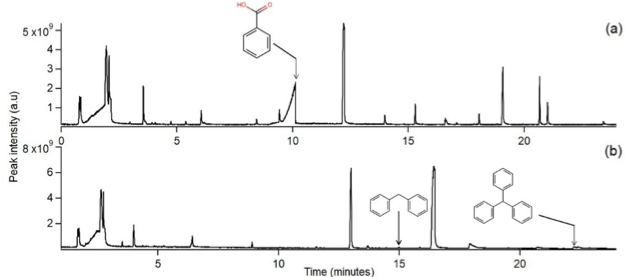- 1Université Paris-Saclay, LATMOS, Planetology, France (ophelie.mcintosh@latmos.ipsl.fr)
- 2Centrale Supelec, Gif sur Yvette, France
Introduction. The harsh oxidative and radiative conditions of the Martian environment influence the fate of organic molecules present on its surface. Formation of radical species was suggested to transform organic macromolecules into carboxylic acid through Fenton chemistry (1, 2) or irradiation semiconductor surfaces (3). Aromatic carboxylic acids such as phthalic acid or benzoic acid are thought to be abundant on the Martian surface as they are in stable intermediate oxidation states and can be formed from the oxidation of Polycyclic Aromatic Hydrocarbons (PAHs) (1, 4) or alkylbenzene compounds (4) coming from endogenous or exogenous sources. Because benzene carboxylates are metastable, they should not be entirely oxidized into volatile molecules such as CO2 or O2, but instead, ionized by solar radiation to form organic salts (2, 4, 5). Benner et al. (2000) suggested that the low volatility of these salts could compromise their in situ detection through thermal extraction analyses as performed by analytic chemistry laboratories onboard Martian surface probes, such as the Sample Analyzer at Mars (SAM) experiment onboard Curiosity rover or the Mars Organic Molecular Analyzer (MOMA) instrument of the Rosalind Franklin Exomars rover (4-6). To determine the possibility to identify these molecules through direct or indirect detection on Mars, we examined laboratory results from SAM and MOMA-like Gas Chromatography-Mass Spectrometry (GC-MS) analyses of two acid/salt couples (phthalic acid/calcium phthalate and benzoic acid/calcium benzoate). We analyzed the difference in behavior and signatures of both molecular forms when using pyrolysis and wet chemistry experiments used in SAM and MOMA, and the relevance of these results in the search of organic molecules on Mars.
Method. Synthetic samples were made by mixing the carboxylic acid molecules or their organic salts standards at 1wt.% in fused silica, to simulate a relatively inert mineral matrix. The samples were pyrolyzed in SAM-like conditions with a ramp of 35°C.min-1 and in MOMA-like conditions in flash pyrolysis at 500°C and 800°C. The volatiles released from each sample were analyzed by Evolved Gas Analysis (EGA) and Gas Chromatography-Mass Spectrometry (GC-MS). We also performed derivatization experiments to help detect refractory organic compounds, with N,N-methyl-tert-butyl-dimethylsilyltrifluoroacetamide (MTBSTFA), used for wet chemistry experiments in SAM, and N,N-Dimethylformamide dimethyl acetal (DMF-DMA), to be used in the MOMA experiment of the ExoMars mission.
Organic acid/salt behavior under pyrolysis conditions. As predicted by Benner et al. (4), when analyzed through pyrolysis-GC-MS, the organic salts species did not produce the organic parent molecule (phthalic acid or benzoic acid (Fig. 1 (a)). However, we have identified two by-products characteristic of the degradation of the organic salts, diphenylmethane (Fig. 1 (b)) and triphenylmethane (Fig.1 (b)) which were absent of the chromatograms of the acid species. These results show that for both carboxylic acid couples studied, the acid and the salt don’t follow the same degradation pathway resulting in differences in the species detected as well as major differences in the abundance of products observed in the chromatograms. This means that if carboxylic acids are present on Mars in their saline form linked to calcium cations, we would not be able to identify it through the detection of its acid form with the SAM nor MOMA pyrolysis set-ups, but rather through the detection of characteristic by-products that would serve as indirect clues for identification.

Figure 1. Chromatograms obtained under the same analytical conditions as the pyrolysis in SAM. (a) benzoic acid mixed at 1 wt. % in fused silica and (b) calcium benzoate mixed at 1 wt. % in fused silica.
Organic acid/salt derivatized with MTBSTFA and DMFDMA.
Figure 2. Bar chart representing the abundance of derivatized benzoic acid obtained with calcium benzoate and benzoic acid. The derivatization reagent used was DMFDMA (a) and MTBSTFA (b).
When derivatized with DMFDMA or MTBSTFA, both the acid and the organic salt produced the derivatized product of the carboxylic acid. Both the phthalic acid and benzoic acids have a higher derivatization yield than their salt counterpart with both derivatization reagents. This is likely due to a better availability of the hydrogen on the carboxylic acid function. Moreover, we obtained a higher yield of both the acid and the salt with MTBSTFA than with DMF-DMA, with the loss of detection of calcium phthalate derivative with the latter. In conclusion, if present in the Martian soil, aromatic organic salts could be directly detected through wet chemistry experiments, showing the complementarity of this technique with pyrolysis.
References. (1) Oró et al. (1979) Life Sciences and Space Research, 77-86. (2) Donald et al. (2013) Science. (3) Fox et al. (2019) Journal of Geophysical Research: Planets 124, 3257-3266. (4) Benner et al. (2000) Proceedings of the National Academy of Sciences 97, 2425-2430. (5) Lasne et al. (2016) Astrobiology 16, 977-996. (6) Hakkinen et al. (2014) Environ Sci Technol 48, 13718-13726.
How to cite: Mcintosh, O., Szopa, C., Freissinet, C., Buch, A., and Boulesteix, D.: Analysis of aromatic organic salts with gas chromatography-mass spectrometry and implications for their detection at Mars surface with in situ experiments , Europlanet Science Congress 2022, Granada, Spain, 18–23 Sep 2022, EPSC2022-590, https://doi.org/10.5194/epsc2022-590, 2022.

